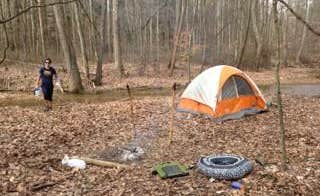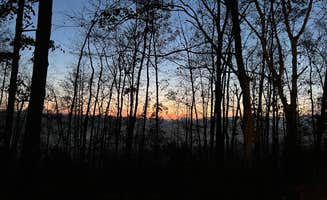Dispersed camping near Madison, Indiana offers opportunities in several areas of the Hoosier National Forest. Terrain varies from rolling hills to ravines with elevation changes of 300-600 feet across most sites. Summer temperatures average 85°F with high humidity, while spring and fall provide milder conditions. Winter camping remains possible with temperatures rarely dropping below 20°F for extended periods.
What to do
Hiking forest trails: At Knobstone Trail, hikers encounter challenging terrain with multiple access points. "The KT is rugged and has lots of elevation gains over short distances," notes Maris H., who recommends bringing water filtration equipment due to seasonal variations in water quality.
Wildlife observation: Morning hours provide optimal wildlife viewing opportunities. Small mammals, deer, and numerous bird species frequent most sites. Camper Reuben R. from Berry Ridge Road reports, "Every night at around 5pm I would hear rustling in the leaves, I assumed it was a pack of cayotes and they would leave once I started banging on stuff."
Seasonal foraging: Spring brings morel mushrooms while fall offers pawpaws and persimmons in mature forest areas. Always verify species before consuming. Steven G. notes that at Sundance Lake, "On the weekends, the activity picked up with a lot of partying and hunting."
What campers like
Site privacy: Campers value the separation between sites. "The perfect dispersed site for my way through, quiet and peaceful," writes Samuel C. about Berry Ridge Road. Another camper, Ozzie L., confirms: "Each site is fairly far apart. It's really quite only seen a handful of cars drive by and I've stayed here for 2 nights."
Accessibility with seclusion: Primitive camping near Madison, Indiana offers sites that balance accessibility with wilderness feel. Brian S. notes about BerryRidge Road Dispersed Camping, "This was a great place to car camp while driving across USA. The main spot was full but I found a great pull off spot a lil further. I came across at least 5 lil spots."
Minimal traffic: Most dispersed sites experience limited vehicle traffic, especially midweek. David S. describes BerryRidge Road as "A hidden gem. Just a few sites along the road minimum traffic encountered."
What you should know
Water availability: Water sources require treatment before consumption. No potable water exists at most sites. Knobstone Trail hikers should note that "You're never too far from water, although the quality may differ depending on the time of year," according to Maris H.
Navigation challenges: Some sites prove difficult to locate without proper directions. Desert B. attempted to find Knobstone Trail and reported: "I drove back and forth on the road several times looking for this place. The only thing I found was what I believe was the entrance with a cable across it."
Campsite conditions: Jackson Trailhead requires exploration to find suitable spots. "There's parking after a decrepit gravel road and suitable for camping. There are campsites along the trail just have to find them," explains Logan.
Limited facilities: True primitive camping means no amenities. Julie from Sundance Lake Dispersed Camping explains the area has "National forest area with 3ish campsites one of which can accommodate a vehicle. Wooded so no solar or starlink. Small lake nearby with what looks like some trails."
Tips for camping with families
Fire safety precautions: Most sites permit fires in established rings only. Collect only downed wood from surrounding area. "Multiple campsites in the area, I've stayed at two both of which were away from others, clean, fairly flat and had plenty of dead wood around to burn," shares Jeremy F. about Berry Ridge Road.
Insect preparation: Pack repellent and conduct tick checks after outdoor activities. Long sleeves and pants recommended even in warm weather. Maris H. warns about Knobstone Trail: "Watch out for ticks. My dogs and I got loads of them in April 2020 from Leota to Spurgeon Hollow."
Site selection for comfort: Choose sites with flat areas for tents. Susan C. from Knobstone Trail suggests, "The sites are spacious, and there are a lot of nature things to do."
Tips from RVers
Vehicle access limitations: Most dispersed sites accommodate small to medium vehicles only. Large RVs should seek established campgrounds instead. At Berry Ridge Road, James W. emphasizes: "For those of you who don't understand disperse camping this is the perfect site for a tent to camp without anything but what you bring in and take out."
Road conditions: Many access roads become challenging after rainfall. High-clearance vehicles recommended for several areas. Amber R. shares her Berry Ridge Road experience: "I have a promaster conversion and had no trouble making it to this site, however the road was gravel and steep at times."
Size considerations: Smaller conversion vans and truck campers fare best at these primitive sites. Palynn F. confirms about Berry Ridge Road: "Not very big, I would not bring a Rv here especially after rain."



